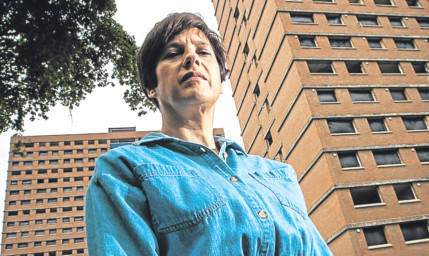A Dundee academic has lamented the imminent demise of the Derby Street multis, believing it will deprive the city of much-needed social housing.
The city council does not accept the reasoning of Dr Sarah Glynn, who yesterday revisited the site that is due to be cleared on Sunday when Butterburn and Bucklemaker Courts are demolished.
The former secretary of the Derby Street Multis Residents’ Association has produced her account of the soon-to-be concluded episode, which she has entitled How The Council Destroyed Oor Hoosis.
She has presented the document to the city council, and yesterday she said: “I hope that when 374 flats are reduced to rubble on Sunday, the council’s housing department will refrain from repeating their myth that these homes were not wanted.
“As our tenants’ surveys demonstrated, the great majority of Butterburn and Bucklemaker tenants wanted to stay in their multis.
“When the city council first debated the demolition nine years ago, we showed that this was part of a deliberate policy aimed at reducing the amount of social housing in the city.
“That did not make sense then, with thousands of households on the housing waiting list. It makes even less sense now that growing numbers of households can’t afford to buy a home and are having to live in rented accommodation.”
In a clearly political version of the multis’ history, she claims the council’s assertion that the demolition of the unwanted dwellings would save money was disproved, yet the council pressed on.
“The council said that they would sell the land to the developer. The developer would build new houses for people to buy and sell. This would make Dundee a better place for richer people to live but they didn’t say where the poorer people would go.”
The global financial crisis affected house-buying and more people wanted houses to rent, but most of these houses had been sold or destroyed, she says.
Her essay says Dundee’s current SNP administration first indicated they could think again about Derby Street, but the council policy didn’t change.
This was in spite of figures apparently showing that upgrading the flats would cost less than building new homes on the site.
The council said most of Dundee’s multis were built between the mid-60s and early-70s, and by 1991 there were 49 multi-storey buildings.
Since then, as housing preferences changed, flats in multis became increasingly difficult to let and as a result were declared surplus by Dundee City Council.
More than two-thirds of the 1991 figure have been demolished to be replaced with houses tenants find more desirable.
“The Hilltown Regeneration Framework aims to review and remove unpopular housing, ensure that houses demolished are replaced by new housing including a range of tenures, and to enhance the overall area as an attractive place to live,” a council spokesman said.
“In partnership with the local community, Dundee City Council is identifying development partners to deliver the vision for the Hilltown, which includes a new school and community facilities on the site of the former Alexander Street multis. The council will be inviting developers to express any notes of interest for new housing on the Derby Street site in the near future.”
